
Istanbul:
City of the Future
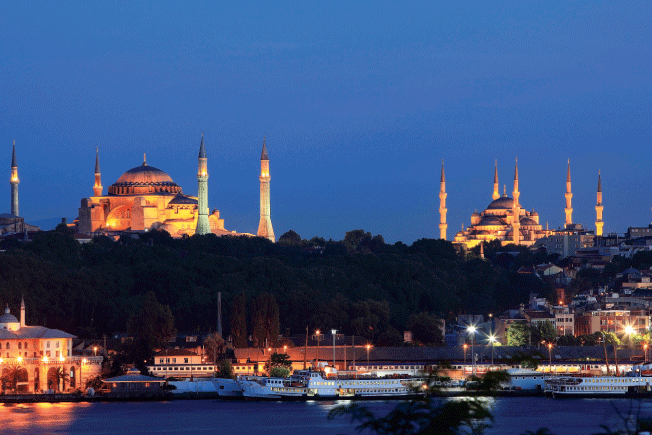 |
This city is where the Islamic world meets the global order,
serving as a bridge between Europe and the outer edges of Asia.
By Pico Iyer*
On sofas overlooking the lights of the city, salon-tanned kids stretched out in another corner or the regular popcorn counter serving up Pepperidge Farm cookies and rubs of Haagen-Dazs. It took me a while to realize that these glamorous teenagers weren't here to see "Public Enemies"; they'd come to the cinema lobby just to make the scene.
I'd heard for years that Istanbul, one of the official European Capitals of Culture for 2010, calls itself "Europe's coolest city." It's certainly one of the most complex – the center of a country that is 98 percent Islamic.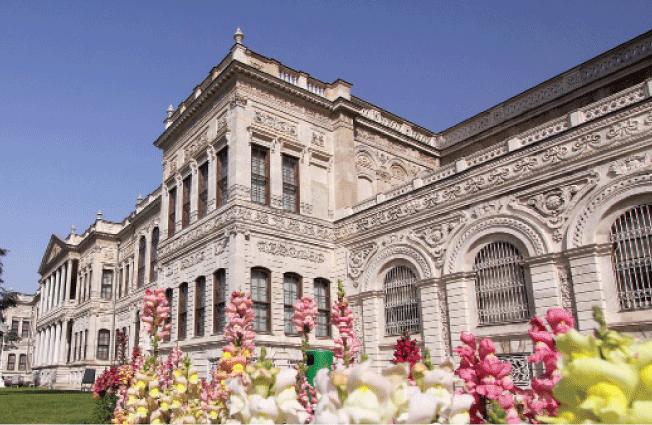
Here is a place whose Blue Mosque has an LCD screen flashing the time in Paris and Tokyo. Turkey's most cosmopolitan metropolis has more billionaires than any city but New York, Moscow, and London, and when I went to the Istinye Park Mall there, it was to see Aston Martin DB9s and Bentleys jammed outside a gilded avenue of fortresses labeled "Almani," "Gucci," "Vuinon," "Dior."
To my friends in business in New York, and to many proud Istanbulians, this city is where the Islamic world meets the global order, serving as a bridge – literal and metaphorical – between Europe and the outer edges of Asia.
But still nothing had prepared me for the flash and glitter of it all. After I'd taken in Matthew McConaughey mumbling sweet nothings at the Citylife Cinema, I went across the street to the Sofa Hotel, and, setting foot in its elevator, found myself inside a kind of psychedelic light show, new colors coming through the transparent wall at every stop. When I started walking back toward the center of the city, I saw a woman in head-to-toe chador entering Starbucks to buy an espresso-flavored version of the jellied candy known as Turkish delight.
In the Grand Bazaar earlier that day,
I had even seen carpets inscribed with the mystical words "University of Baltimore."
We foreigners like to recall that Istanbul is the only city on Earth with one shore in Asia and one in Europe. But its real heart, according to its eloquent native son, Orhan Pamuk, in his evocative memoir, "Istanbul: Memories and the City," lies rather in the division between the old (which is usually the local and the Islamic) and the new (generally the Western and the secular) .
The relation between the two is still tense: I had to walk through a security machine just to go to the movies. And Pamuk himself, though Turkey's most famous modern citizen, was brought to trial in 2005 simply for mentioning his country's brutal treatment of Armenians in 1915 (the next year, perhaps in response, he was awarded the Nobel Prize in Literarure).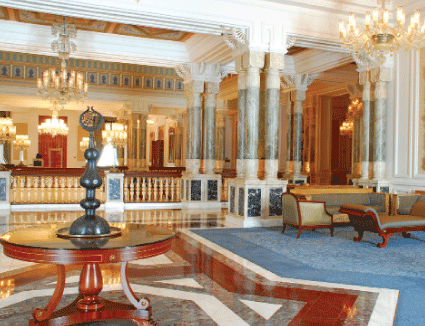
But the fascination of Istanbul today is that it seems as compressed and vital a model of the larger globe as you could find; one morning, when I awoke just before dawn, I could hear the call to Islamic prayer from every minaret, even as I could faintly make out the sound of the latest hip-hop music pounding along the streets. When I went to sleep after nightfall, it was to the accompaniment of the same unlikely duet, tile competing sounds now coming together, now seeming to clash.
I've always been something of a global creature: I was born in England to parents from India, and I grew up in California, though I live now in Japan-and so, for much of my life, I've been seeking out global places that are trying to piece together, as I am, disparate cultures and identities, to make a stained glass whole. Istanbul is most attractive to many for its complex, layered pastits harems and mosques and cemeteries and bazaars; but for me it's intriguing as an image of the future. It was no surprise, I thought, that President Obama visited the city within three months of taking office (a picture of the president, head respectfully bowed, greeted me as I walked into the basilica turned mosque turned museum, Hagia Sophia).
The minute I arrived in town – my first trip back in more than 20 years – I could feel the contemporary excitement that makes Istanbul one of the hottest destinations around. The narrow, cobblestoned streets around Ortakoy Mosque were so crowded on a Saturday evening, close to midnight, that I could hardly walk.
The particular promise and confidence of the city today lies to some extent in the fact that it has been three times the center of the world; for centuries it has known how to talk and trade with Russia to the north, Iran to the east, Central Asia just behind, and Europe all around. Unlike a Dubai or an Abu Dhabi, say, it can be in tune with the future precisely because it has so rich a sense of the past and such seasoned wisdom about the cycles of culture and history.
I walked into the Spice Bazaar one day and found LCD signs in Japanese (though the merchants there were fast -talking in French and Portuguese and Spanish, while calling out, "Excuse me, lady, it's almost free! "). The minute a few drops of rain began to fall one morning, I saw resourceful locals at tile doors of the tourist buses near the Hagia Sophia flogging umbrellas. And the most commonly seen couples in the backpacker area of the old district of Sultanahmet were beaming young Korean women on the arms of leather-jacketed young Turks who'd just won them over.
Around them, the handful of restored Ottoman boutique hotels that had greeted me in 1986 now numbered 200 and counting. Everywhere there seemed to be a natural savoir faire that reminded me of cities like Mumbai and Shanghai, able to rise from every setback to put themselves in sync with the moment. 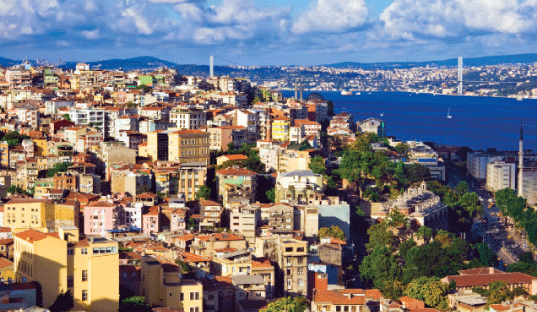
Yet for all the racy Italian fashion ads (on the Asian side of town) and for all the enterprising salesmen laying down carpets on the streets at 9 p.m. from which to sell toys and electric shavers (on the European side), the city can seem to the anxious as if it's on its way to becoming the next trendy but perennially torn Beirut.
To this day, more than 97 percent of Turkey is Asian, which makes Istanbul an anomaly. And a city of 500,000 souls in 1920 now has to contain up to 25 times that many, as people flood in from the Anatolian heartland, perhaps unsure themselves whether the economic opportunities that their biggest city offers are worth embracing if they also bring with them secular European values. The newspapers were all talking, when I visited, about a new mosque in the Uskudar area, said to be the first such building designed by a woman. But it seemed a fair guess that the silent majority across the country, away from the imported surfaces still saw "hipness" and mosques as pointing in opposite directions.
To go to Istanbul today is to see in bold strokes the conundrum that confronts all the fast-growing old cities in the world as they try to remain simultaneously global and themselves. And in Turkey's biggest city, the setting seems more charged (and more allegorical) than anywhere.
"It's the most eastern part of the West and the most western part of the East," a Turkish student said, when I asked a class in the smallish town of Isparta (through its American teacher) what they thought of Istanbul. He didn't add that that could result in collision as much as in collusion.
It's a bit perverse, I realize, to go to one of the planet's most historic and enigmatic cities just to seek out what can as easily be found in Santa Monica or Tokyo. So in the days after my night in Ortakoy I took pains to pay homage to as many of the sights of old Istanbul as I could. I took a taxi out to the holiest spot in the area, the Eyup Sultan Mosque, and felt something inside me tremble as I saw pious women sobbing outside the place where the Prophet Muhammad's friend Abu Ayyub al-Ansari is said to be buried. I went to the Turkish and Islamic Arts Museum beside the Hippodrome, across from the Blue Mosque, and realized that the 500-year-old palace in which it is housed is as remarkable an artwork as anything inside it.
More than once, while killing time before a ferry, I stole across the street to the Spice Bazaar and slipped through the narrow shopping lanes nearby to the almost hidden flight of stairs that leads to the exquisite – and largely unvisited – Rustem Pasha Mosque, one of the treasures of tile city.
One morning I took myself to Topkapi, arriving early so I'd have the harem and the dazzling gardens almost to myself, and I was so stunned by the place that I went again, at the same time, four days later. And in the evenings, staying in Sultanahmet, I found nothing more magical than just strolling through the dimly lit alleyways, looking in on the Sokollu Mosque minutes before it closed, losing my way in a maze of streets that, even close to the tourist section, retain something of the withdrawn power and mystery of an old and very foreign place.
Yet for all these moments of ancient beauty, I kept trying to remember how Istanbul might look to a Turk, for whom it is an invigorating model of the future. If foreigners are always drawn to what is "Turkish" about the place, the Turks who pour in from the interior are, for equally good reason, drawn toward everything that seems cutting-edge and international. One of the students I'd questioned told me: "People in Turkey say, 'The earth of Istanbul is made of gold."'
It certainly can seem that way around the boutiques and cafes of the privileged quarters. After staying across the street from tile Blue Mosque in Sultanahmet, I moved one day over to the Bentley Hotel, near Nisanrasi, and walked into a minimalist white-and-black lobby with fashion magazines from Sweden laid out on a table. And after checking into a designer room there, I took a taxi down to the Istanbul Modern, whose in-your-face canvases shout out that Turkey today refuses to be boxed inside a foreigner's quaint notions of it.
I got onto a cruise ship traveling up the Bosporus, and as we passed the yali swnmer houses set along the water, I was forcibly reminded that affluence and style are nothing new here; novelist Gustave Haubert, visiting in 1850, had said that Istanbul, a century hence, would be the capital of the world. Then, after catching my breath as the shoreside mansions drifted by, I got off the boat atYenikoy and took a bus back toward the city, along the single-lane coastal road that runs along the water.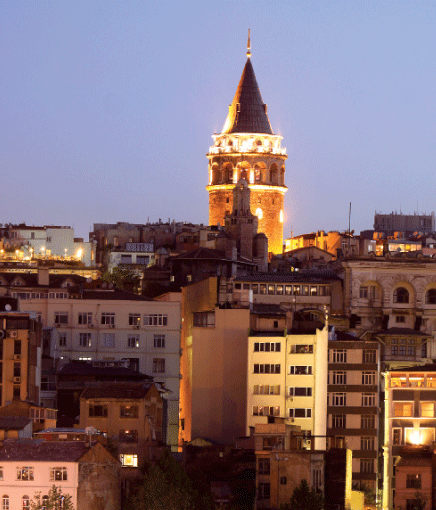
I might have been near Nice and St.- Tropez, I thought, winding through a series of jewel-like villages set against the scintillant blue. At the Sakip Sabanci Museum, I got out to find much of fortunate Istanbul reclining on the museum's lawns, listening to live jazz as men in Polo shirts picked nonchalantly at slices of watermelon; the museum's Getty-worthy restaurant had, in 2007, been named by Wallpaper magazine as one of the hottest new eateries on the planet.
Walking down to Bebek, a little farther south, I stepped into a Starbucks and found a beautiful terrace on the Bosporus itself, a copy of Wired draped across one table. Now I might have been in Sausalito, it seemed, or one of the gorgeous small towns around San Francisco, as I watched boats bob among the white pleasure domes and cars pass across a great suspension bridge in front of me. In tile old wooden houses of Arnavutkoy, not far away, trendy couples were dining on terraces filled with bright flowers, as if posing for a vision of what many young Turks in the countryside might see as the good life.
"Turkey managed to live through, in 2007, the paradox of an elected party rooted in Islamic tradition stating that it wishes to maintain tile secular republic set up by Kemal Ataturk in 1923," Manoutchehr Eskandari-Qajar, a political science professor in California, told me, and it survived the further paradox of the nation's military, determined to protect that secularism, refraining from taking over the new government by force. If Turkey could maintain such a balance, my friend, an expert on the Middle East, had said, he had high hopes for it. But, culturally, the whole country seemed to be perched upon a tightrope.
Just three weeks before I arrived, in fact, the city had placed a ban on smoking in its coffeehouses and eating places; this seemed about as plausible as banning noodles on the streets of Beijing. By the time I began walking around, angry proprietors were already launching loud protests in the streets, claiming that the ruling had stripped them of up to 80 percent of their business. And for those who love Istanbul, the small change seemed symptomatic of a city that was eager to show how European and modem it was, even though its heart – and character – lie in its very pungency and closeness to its Eastern roots.
"Istanbul has always been about raw life, from the murderous driving and yawning potholes in the roads to the physical street brawls and the smoke-filled teahouses," Nigel McGilchrist, a sometime resident of Turkey and author of the "Blue Guide to the Greek Islands" told me of the city he has known for more than 30 years. "It's not Belgium or suburban Gloucestershire; it's the nearest thing to India in the West."
Certainly, even as Turkey cherishes its almost half-century-long wish to become a.formal part of Europe, it seems reluctant to leave behind the ancient identity it still so proudly maintains. For centuries Istanbul has taken in Greeks and Armenians, and in areas like Balat and Fener the echoes of their presence are what give the streets their savor. Yet none of those groups seems to have affected "Turkishness" at the core or colored the city's sense of itself. After a week visiting every corner, I realized I had not seen a single woman working in a hotel or restaurant or cafe.
"I worry," McGilchrist went on, "that Turkey wants to become European in all the stale, bureaucratic ways, without truly embracing any of the important, deep-rooted values of Europe, such as respecting the rights of dissenting writers to express their views."
And as I walked past the Robinson Crusoe bookstore, boasting as good a selection of English-language books as many a counterpart on Sunset Boulevard, as I sat in a little room in the orthodox area of Fatih, I did begin to feel that the power of the city lay precisely in the fact that its next move could never be anticipated. The true nature of Istanbul seems always in dispute – or in passage, at least, like the boats constantly crisscrossing its waterways.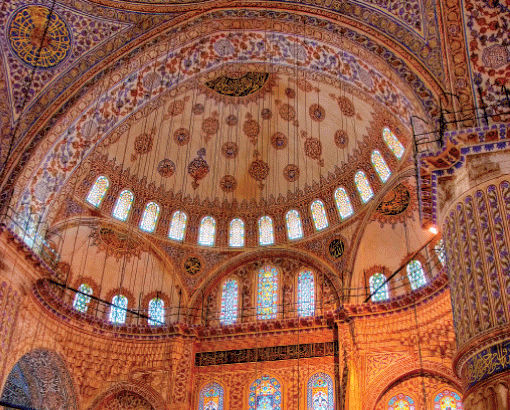
I had seen more chadors and head scarves here than I had noticed in Syria or Egypt, I thought, as I prepared to leave – but the women with blond ponytails were still sipping $20 cosmopolitans among the trendy cafes of Asmalimescit. There were few signs of the poverty I was used to in places like Jakarta or Marrakech; yet outside the glamorous areas, Istanbul did not seem a wealthy city, especially for the millions who stream in and end up in drab apartment blocks ,without the new lives they dreamed of.
Statistically, it claims to be one of the safest cities in Europe, but it didn't strike me as particularly friendly or ebullient. Watchful and guarded, for all its dazzling surfaces and cries of discounts in the bazaar, Istanbul looked to be the place where the age-old reserve of Greece runs into the very different kind of foreignness of Pakistan.
Pamuk had been similarly circumspect in his evocation of the hometown he has been exploring all his life. "This is indeed a city moving westward," he had written, "but it's still not changing as fast as it talks." One day while I was there, phone lines back home to Japan went down for 24 hours. In the Internet cafes I found that Turkish-language keyboards prevented me from logging on to AOL. And as I checked out of my fairly fancy hotel in Sultanahmet, a gracious desk clerk asked me to write in a tip (a first, in my 30 years of travel). I did so – but when he gave me back the bill, I saw that he had doubled the amount, on the sly, because my 10 percent didn't strike him as sufficient.
My very last night in Istanbul, I decided to put all my ideas and thoughts of a global future away. I wouldn't check out another dervish show, What really excited me about the place, I came to realize, was simply the sense of ceaseless movement, the way the energies of an Asian metropolis pulsed through largely European streets, so that the whole place seemed work in perpetual progress. And nowhere was the habit of making hard-and-fast distinctions dissolve more apparent than on the water.
So I stepped onto a ferry in Eminonu, in Europe, and went across to Uskudar, in Asia. On arrival, I passed through the turnstiles, turned around and bought another dolIar token for a ferry passing through the Golden Horn, back to Europe. The sun was just beginning to set, and the late afternoon light turned every face to gold. From every bridge we passed, men had thrown down fishing lines, as I'd never seen from the ferries of Hong Kong or New York.
As darkness began to fall, the sloping streets and minarets turned into a kind of fairyland, the Istanbul of paintings. I got off at the last stop, near Eyup, Sultan Mosque, and bought another jeton to go back to Kadikoy, in Asia. Eighteen boats were crisscrossing the water now, others steered by grizzled, stocky men whose hard faces and dark clothes seemed to speak for a truer, less imported Turkey.
To one side of us, the Bosporus Bridge was turning red and blue and yellow again; to the other, the minarets and mosques of Sultanahmet looked more unearthly than ever, illuminated against a blue-black sky. I got off in Turkish Asia for the last time and looked across the water to head back. As soon as you begin to know a place, I thought, all talk of "old" and "new" or "East" and "West" becomes redundant. Just the movements inside it, the way it comes closer and then slips away:That's all the excitement you need.